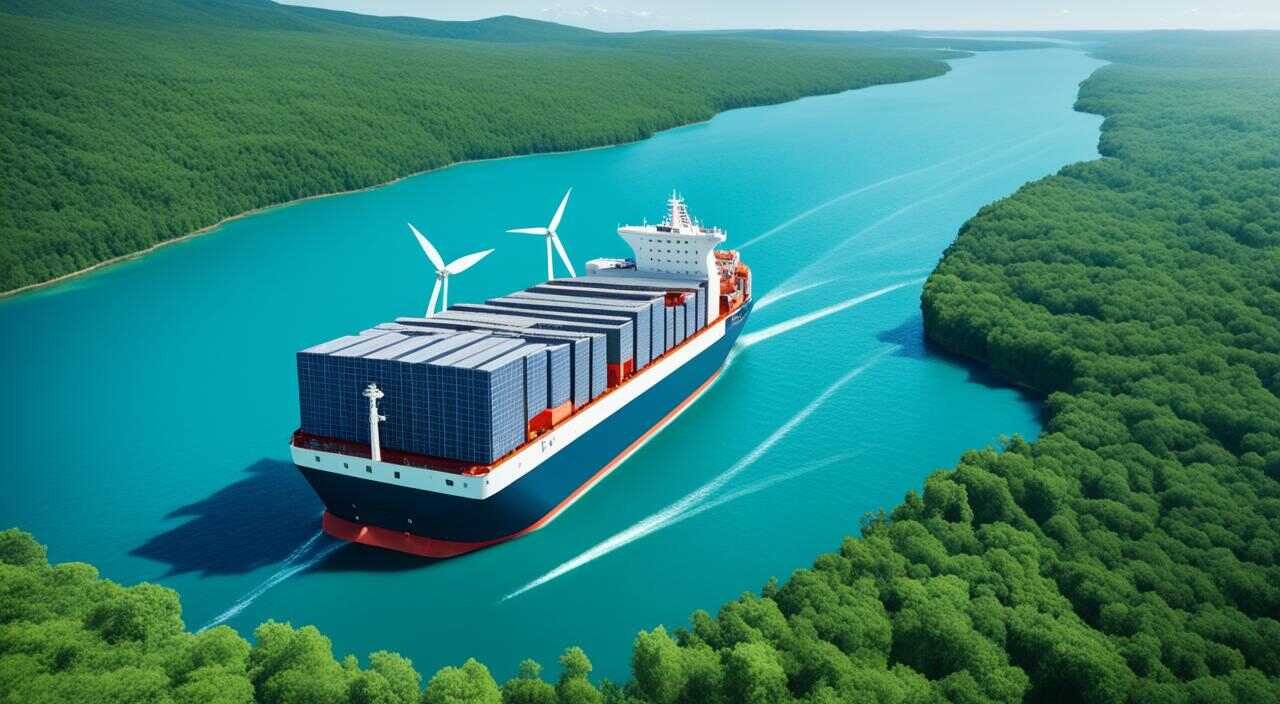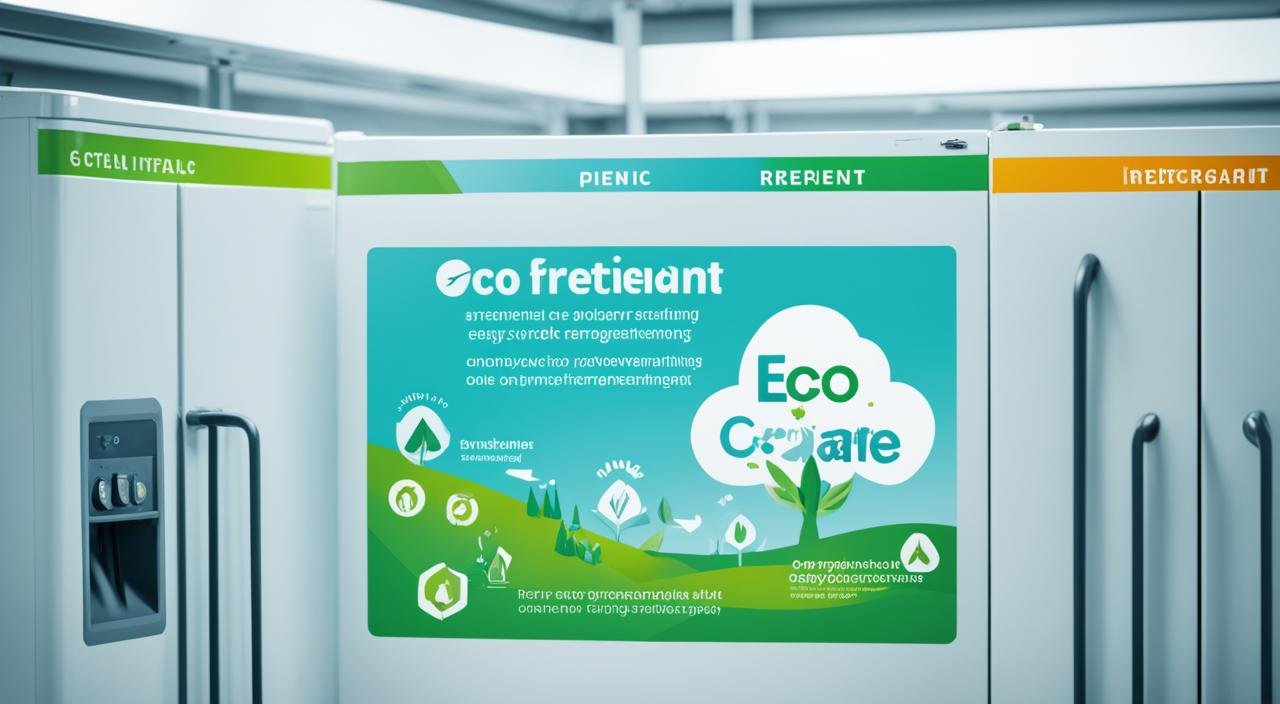Eco-friendly practices are vital for a sustainable future. They help preserve our planet for future generations. Living harmlessly towards the environment and taking steps to protect it contributes to a better world. Embracing green habits and an eco-conscious lifestyle are key.
Actions like reducing waste, saving energy, and making sustainable choices help the environment. Using alternatives to single-use plastics and adopting energy-efficient technologies matter. Every small step we take counts towards a healthier planet.
In this article, we’ll look at eco-friendly actions across various parts of life. We’ll talk about the importance, the benefits of sustainable transportation, and why recycling matters. By learning and applying these practices, we can help create a greener future.
Key Takeaways:
- Eco-friendly practices refer to living in a way that is not harmful to the environment.
- Adopting green habits and embracing an eco-conscious lifestyle are crucial for creating a sustainable future.
- Implementing eco-friendly tips for everyday living can contribute to a healthier planet.
- Reducing waste, conserving energy, and making sustainable choices are all part of eco-friendly living.
- By practicing eco-friendly habits, we can create a more sustainable world for future generations.
The Importance of Being Eco-Friendly
Being eco-friendly is crucial for keeping our planet safe. The IPCC, a global group, warns us about climate changes. These changes are serious and hurt our world. They make the sea levels rise and cause bad weather.
People move because of these problems. This also makes it hard to get and make things we need.
Doing things that are good for the earth helps a lot. It means using things that last a long time and are not harmful. This way, we keep our planet healthy for everyone, now and later.
Addressing Man-Made Damage
“The damage caused by human activities significantly impacts the environment, and we must take responsibility for our actions to protect the planet.” – Dr. Jane Goodall
We cause a lot of harm by using too many resources and making too much waste. Using things like oil and gas for power hurts the atmosphere. It causes the climate to change.
Cutting down trees for farming and building breaks natural homes. This makes animals and plants disappear. Throwing our trash in the wrong places makes the earth dirty, hurting nature even more.
Climate Change and Global Supply-Demand Dynamics
Climate change affects how much food and other things we have and how much they cost. Bad weather can make it hard to grow food. Rising seas can flood cities where many people live.
This can hurt our roads, jobs, and the way we live.
The changes are more than just environmental. They can make some people have less than others. This might make some areas not safe or healthy. We can fight this by being friendly to our planet everyday.
The Role of Eco-Friendly Actions
Everyone needs to do their part in protecting our earth and fighting climate change. We can do this by using less energy and by not wasting as much. It’s also important for governments and companies to set rules that help the planet.
| Eco-Friendly Actions | Benefits |
|---|---|
| Transitioning to renewable energy sources | Reduces dependence on fossil fuels and mitigates climate change |
| Adopting energy-efficient practices | Reduces energy consumption, lowers utility costs, and minimizes environmental impact |
| Promoting sustainable agriculture | Preserves soil health, protects biodiversity, and ensures food security |
| Reducing waste and implementing recycling programs | Minimizes resource depletion, decreases landfill waste, and conserves natural resources |
| Supporting sustainable transportation | Reduces carbon emissions, improves air quality, and lessens traffic congestion |
To make a better future, we must all work together. Doing things to help our planet every day is the key. This changes how we live and makes the earth better for all.
Eco-Friendly Practices in Different Areas of Life
People can help the planet by being eco-friendly in various ways. This applies to many parts of life, making it easier to live sustainably. There are several steps, from upgrading homes to using less and choosing eco-friendly travel.
Energy-Based Home Improvements
Boosting eco-friendly living starts at home. Improvements like solar panels, better insulation, and efficient appliances use less energy. This not only helps nature but saves money in the long run too.
Reducing Over-Consumption
Using less is also a big part of being eco-friendly. It means buying only what you need and choosing well-made products with less packaging. This way, we throw away less and live a more eco-minded life.
Emissions Reduction
Lowering our emissions is vital for a green planet. We can do this by walking, biking, sharing a ride, or using public transport. Less driving means we cut down on the stuff that harms the earth.
Eco-Tourism Habits
Even trips can be made eco-friendly. Staying in places that care for the environment and helping local areas is good for Earth. It ensures that we enjoy nature without hurting it.
Living and traveling in eco ways makes a huge difference. It leads to a future where our planet is healthy. Every choice we make, big or small, helps keep our world green.
Eco-Friendly Tips for the Home
Making your home eco-friendly is great for Mother Earth and cuts down on your carbon footprint. You can help the planet by making easy changes in your daily life. These tips will lead us to a greener future:
1. Solar Photovoltaic Installations
Think about adding solar PV panels to your roof. They turn sunlight into power, reducing the use of energy from bad-for-the-planet sources. This means less harm to earth and smaller electricity bills.
2. Energy-Saving Light Bulbs
Swap your old light bulbs for LED or compact fluorescent ones. They last longer and use less energy. This simple step helps in saving power and living more sustainably.
3. Eco-Friendly Cleaning Products
Choose cleaning products that are gentle on the earth and on you. Go for items marked as “biodegradable” or “safe for the environment.” Using these means less pollution and a healthier home.
4. Insulation and Weatherproofing
Keep your house cozy without wasting energy by sealing it well. Good insulation and sealing doors and windows stop heat or cool air from escaping. This helps save energy and money on bills.
“By making our homes more sustainable, we protect the planet and set a good example for the future.” – Green Living Magazine
By following these tips, you’re doing your part to be kinder to the earth. Your home becomes a better place for both you and the environment. Let’s work together for a brighter tomorrow.
Reducing Waste and Plastic Usage
Reducing waste and plastic usage is vital for an eco-friendly life. We do this by cutting down on single-use plastics. Instead, we choose sustainable ways to reduce waste, making the environment better.
The Dangers of Single-Use Plastics
Plastic bottles and coffee cups are big issues for waste and pollution. After one use, they often end up in the wrong places, like the trash or the ocean. There, they can harm the environment for many years. Using things that can be used over and over helps lower the trash we make.
Composting for Waste Reduction
Composting turns food scraps and such into good soil. It keeps these things out of landfills. This helps reduce the bad gases that hurt our climate. Plus, it makes soil perfect for growing things.
The Importance of Recycling
Recycling old materials is very important. It helps us use less new stuff and energy. By recycling the right way, we send less trash to bad places and save precious resources.
Embracing Waste Reduction Practices
Being smarter about what we use makes our world cleaner. We can do this by reducing, reusing, and recycling. This way, we leave a smaller mark and help the Earth stay green for the future.
| Waste Reduction Strategies | Benefits |
|---|---|
| Avoiding single-use plastics | – Minimizes waste – Reduces pollution – Conserves resources |
| Implementing composting practices | – Diverts organic waste from landfills – Reduces methane emissions – Creates nutrient-rich soil |
| Proper recycling of materials | – Conserves resources – Reduces waste sent to landfills – Decreases the need for raw materials |
| Adopting reduce, reuse, and recycle principles | – Minimizes ecological footprint – Promotes sustainable living – Contributes to a greener future |
Sustainable Transportation Options
Choosing eco-friendly ways to travel is key for a green lifestyle. By using less personal cars, we cut down on harmful gases. This also lowers air and traffic pollution. Here are some green ways to get around:
Public Transportation
Public transport like buses and trains is great for the planet. It shrinks everyone’s carbon footprint. Less traffic means less fuel is used and fewer harmful gases are released. It’s also a smart choice for our wallets and it connects people in our communities.
Carpooling
Sharing rides with others going your way is smart. Carpooling cuts down on cars, which lowers pollution. Plus, it saves money for everyone involved. It’s a win-win for the planet and your budget.
Alternative Commute
Biking or walking is good for you and the Earth. No use of fuel means no pollution. It’s also a great way to stay fit and feel good. This is a good choice for short trips or city areas.
Taking steps to reduce carbon is important. We can do this by choosing things like public transport, carpooling, biking, or walking. Every small decision matters for a cleaner planet and a future that will last.
Incorporating Nature into the Workplace
Adding indoor plants to workspaces brings many good things. They look nice and clean the air. This can make the air inside your office better for you. Also, they help lower stress.
Studies show that indoor plants can filter out bad stuff in the air. This includes things like benzene and formaldehyde. These are often in the air at work. Cleaner air means a place more people want to work in.
Plants at work can make you feel better. It can make you less stressed and happier. People working near plants are often more focused and do a better job. This is because plants help us feel peaceful.
Having plants at work can even save energy. Plants can naturally cool the air. This means you might not need as much air conditioning. This can save your boss money on energy bills. Plus, it’s better for the Earth.
Putting plants in your office is an easy way to make things better. It makes the air cleaner and lowers stress. It also helps save energy. This is good for everyone and the world we live in.
Energy Efficiency in Buildings
It’s vital to make buildings more energy efficient for a greener world. Companies can save a lot on energy costs while reducing their impact on the planet. Let’s look at some great ways to make buildings more energy efficient.
Building Insulation
Putting the right insulation in a building is top-notch for energy savings. It keeps the inside just right, needing less heating or cooling. Insulating walls, roofs, and floors makes a place comfy and saves energy. It also cuts down on outside noise, making work areas nicer and quieter.
Efficient Heating and Cooling Systems
Good HVAC systems go a long way in saving energy. They keep the perfect temperature without wasting energy. Better systems use tech to control air well and keep costs down. Plus, they improve the air we breathe, making workspaces healthier and more enjoyable.
Energy-Efficient Lighting
Lighting takes up a lot of a building’s energy use. But, swapping to LED lights can save tons of energy. LEDs are efficient, last longer, and don’t get as hot as old-style bulbs. Adding sensors and controls that turn lights off when not needed also helps save energy.
Cost Savings
Going green is also a big win for a company’s wallet. Using less energy means smaller bills and more money for other projects. Plus, eco-friendly buildings are more attractive to green buyers. This can bring extra financial benefits in the future.
Making buildings more efficient is a win-win for the earth and a company’s finances. With the right insulation, HVAC, lighting, and saving strategies, businesses can cut their energy use. This helps the planet and their profits.
“Improving energy efficiency in buildings is not only an environmental responsibility but also a smart financial decision.” – Green Solutions Magazine
Creating a Culture of Recycling
Building a culture of recycling at work reduces waste and helps our planet. By starting a recycling program and teaching employees how to recycle right, we cut down on landfill waste. This makes a big difference for our environment.
Getting employees involved in recycling makes them feel responsible. It also helps our workplace be more eco-friendly. When they know recycling is key to waste reduction, they’ll do their part. They’ll use these green practices every day.
Want to get more people recycling? Put recycling bins everywhere they can see. Then, show them what goes in and what doesn’t. This makes it easy to recycle right. Also, tell them how recycling helps nature. They’ll learn why it’s important and want to help.
The Role of Employee Education
Teaching employees about recycling is very important. Offer training, workshops, and materials so they know what to do. This helps them make smart choices for our planet.
Education is the most powerful tool we can use to change the world. – Nelson Mandela
Well-informed employees are eager to join recycling programs. They see their part in making less waste and helping our environment. Education also makes them care more. They’ll start being green at work and home.
Creating a Collaborative Environment
Working together is key to a great recycling culture. Make teams that mix people from different parts of the company. Their job is to find new, green ideas. This brings everyone together to think of ways to help our planet.
Don’t forget to cheer for those doing great in recycling. Use events or awards to say thanks. This keeps everyone excited to keep working together.
Achieving Long-Term Sustainability
To stay green for the long run, recycling must be part of who we are. Aim to use less paper and choose eco-friendly stuff whenever you can. This shows we’re serious about helping our environment.
Want to do more? Team up with recycling and waste companies. They’ll help you dispose of things right and keep you updated on new ways to recycle. This way, we help grow a greener world.
Recycling turns things into other things, which is like magic.- Unknown
We all need to keep working at this. Together, with everyone’s effort, we can make a real difference. Let’s keep doing our best for the planet.
The Benefits of Eco-Friendly Practices for Businesses
Using eco-friendly methods in business has many perks. It saves money by cutting down on energy use and waste. This also lowers the costs of daily operations. It improves the company’s finances. Plus, being green makes customers like you more.
Consumers now often pick eco-friendly brands. They want products that won’t harm the planet. This makes a company’s image super important to buyers. Going green helps keep customers happy, leading to more business.
A green workplace also cheers up the team. Knowing they work for a company that cares lifts morale. Employees are happier and more engaged. This leads to better work and satisfied staff.
The cool workplace draws in top talent, too. Skilled workers like to join firms that share their saving-the-earth values. Showing off green efforts can get you the best workers who care about our planet’s future.
Lastly, going green cuts down on waste and helps the planet. By recycling and managing waste better, companies do their part for a cleaner earth. These actions show they’re serious about being responsible.
“Sustainability is no longer just a trend; it’s becoming a necessity for businesses. Embracing eco-friendly practices is not only the right thing to do for the environment but also a strategic decision that offers numerous benefits, including cost savings, improved customer loyalty, enhanced employee morale, and waste reduction.
Eco-Friendly Practices in Action
Let’s see how companies are eco-friendly:
| Eco-Friendly Practice | Benefits |
|---|---|
| Energy-efficient lighting and equipment | Cost savings through reduced energy consumption |
| Waste reduction and recycling programs | Minimized environmental impact and improved sustainability |
| Sustainable supply chain management | Enhanced brand reputation and increased customer loyalty |
| Employee wellness initiatives | Improved employee morale, well-being, and job satisfaction |
By using these practices and more, companies help the planet and themselves. They save money, keep customers happy, and make employees proud. It’s good for everyone and everything.
Conclusion
It’s vital to embrace eco-friendly practices for a sustainable future and protect our planet. By living green and being mindful of our choices, individuals can help the Earth. Ways like saving energy and reducing waste make our world better for those to come.
FAQ
What are eco-friendly practices?
Eco-friendly practices help protect our planet. They involve green habits and an eco-conscious lifestyle. This means doing things that don’t harm the environment.
Why is being eco-friendly important?
It’s vital to prevent man-made harm to our planet. Climate change is causing big problems worldwide. By being eco-friendly, we can lessen these issues and keep our world safe for everyone.
In what areas of life can eco-friendly practices be implemented?
You can be eco-friendly in many ways. This includes improving your home’s energy use, buying less, and choosing sustainable products. Also, consider eco-tourism options for your travels.
What are some eco-friendly tips for the home?
Change your home to reduce its impact. Use solar power and energy-saving light bulbs. Clean with eco-friendly products and make your home more energy efficient.
How can waste and plastic usage be reduced?
To cut back on waste and plastic, start by saying no to single-use items. Compost what you can and recycle right. Make reducing waste a daily goal.
What are some sustainable transportation options?
Sustainable travel is key for an eco-friendly life. Choose walking, biking, carpooling, or public transport. This cuts down on fossil fuel use and pollution.
How can nature be incorporated into the workplace?
Nature at work boosts health and mood. Use plants to clean the air and lower stress. They also save energy and make the air fresher.
What are some energy efficiency measures for buildings?
To make buildings greener, focus on energy use. Improve insulation, use efficient systems, and LED lights. These steps save money and help the planet.
How can a culture of recycling be established in the workplace?
Making recycling a norm at work is great for the environment. Start a recycling program and educate your team. Get everyone involved in keeping the workplace green.
What are the benefits of eco-friendly practices for businesses?
Going green benefits businesses in many ways. It saves money, boosts how customers see you, and makes employees happier. It also helps build a strong, positive workplace.
Why is embracing eco-friendly practices important?
It’s key for a sustainable future. We all need to live green to protect the earth. This way, we help make a better world for those to come.





